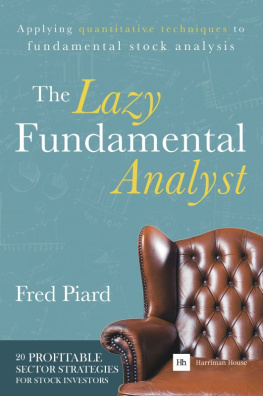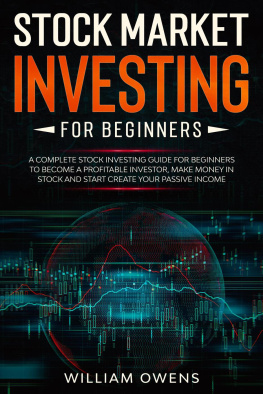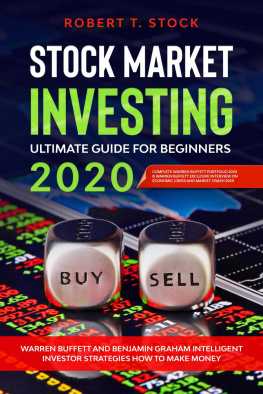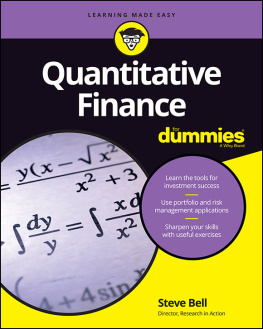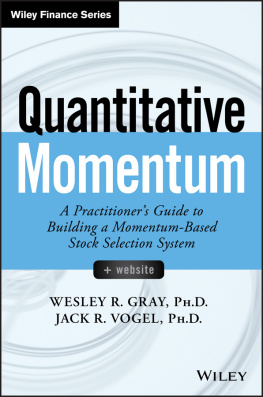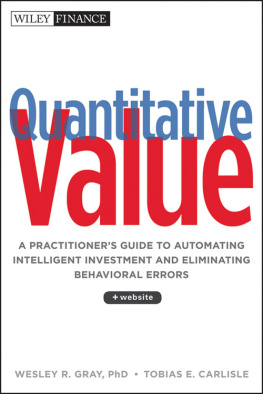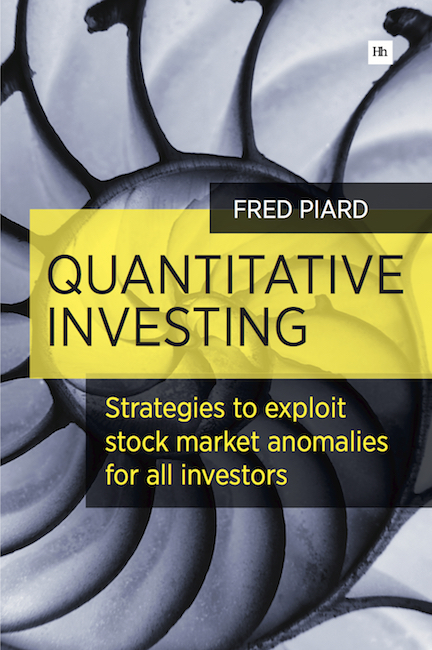Quantitative Investing
Strategies to Exploit Stock Market Anomalies for All Investors
Fred Piard
HARRIMAN HOUSE LTD
18 College Street
Petersfield
Hampshire
GU31 4AD
GREAT BRITAIN
Tel: +44 (0)1730 233870
Email: enquiries@harriman-house.com
Website: www.harriman-house.com
First published in Great Britain in 2013
This revised ebook version, 2016
Copyright Fred Piard
The right of Fred Piard to be identified as the Author has been asserted in accordance with the Copyright, Design and Patents Act 1988.
eISBN: 978-0-85719-349-0
British Library Cataloguing in Publication Data
A CIP catalogue record for this book can be obtained from the British Library.
All rights reserved; no part of this publication may be reproduced, stored in a retrieval system, or transmitted in any form or by any means, electronic, mechanical, photocopying, recording, or otherwise without the prior written permission of the Publisher. This book may not be lent, resold, hired out or otherwise disposed of by way of trade in any form of binding or cover other than that in which it is published, without the prior written consent of the Publisher.
No responsibility for loss occasioned to any person or corporate body acting or refraining to act as a result of reading material in this book can be accepted by the Publisher, by the Author, or by the employer(s) of the Author.
Contents
Disclaimer
The information provided in this book is for educational purposes only. It is not investment advice. Before deciding to invest in financial markets you should carefully consider your investment objectives, level of experience, and risk appetite. The possibility exists that you could sustain a loss of some or all of your initial investment. You should seek advice from an independent financial advisor if you have any doubt.
All products, ETFs, tools and websites quoted in this book are the property and trademarks of their respective issuers. This work provides information about various investment methods. It does not constitute an offer, a financial promotion, or a solicitation to purchase or sell any financial instruments.
No representation is being made that any investor will achieve results similar to those discussed here. The past performance of a system or methodology is not necessarily indicative for the future. The results presented in this book are mostly based on simulations. They have been made as realistic as possible. However there is a risk of errors from the data, software, and human operator.
CFTC RULE 4.41 HYPOTHETICAL OR SIMULATED PERFORMANCE RESULTS HAVE CERTAIN LIMITATIONS. UNLIKE AN ACTUAL PERFORMANCE RECORD, SIMULATED RESULTS DO NOT REPRESENT ACTUAL TRADING. ALSO, SINCE THE TRADES HAVE NOT BEEN EXECUTED, THE RESULTS MAY HAVE UNDER-OR-OVER COMPENSATED FOR THE IMPACT, IF ANY, OF CERTAIN MARKET FACTORS, SUCH AS LACK OF LIQUIDITY. SIMULATED TRADING PROGRAMS IN GENERAL ARE ALSO SUBJECT TO THE FACT THAT THEY ARE DESIGNED WITH THE BENEFIT OF HINDSIGHT. NO REPRESENTATION IS BEING MADE THAT ANY ACCOUNT WILL OR IS LIKELY TO ACHIEVE PROFIT OR LOSSES SIMILAR TO THOSE SHOWN.
About The Author
Fred Piard gained extensive experience in the software industry, information systems consulting and marketing before discovering an interest in the financial markets. Self-taught in this field, he puts into practice what he learnt from his previous activities to build his own methodology. From his years in research he has the ability to combine a systemic point of view and an analytic approach. As a software architect he knows that the things that work the best in the long term are the simplest. As a consultant he experienced the real economy through various sectors: energy, banking, healthcare, manufacturing and public administration. And he learned from marketing that human group behavior can sometimes be modeled, but never predicted. He has a PhD in computer science, an MSc in software engineering and an MSc in civil engineering.
Acknowledgements
Special thanks to Stephen Eckett at Harriman House, for his help from the initial idea to the final manuscript.
Preface
Who this book is for
This book was written for anyone looking for simple, effective and low-risk investing strategies. The strategies described in the following pages can be managed in just five minutes a week, sometimes much less, making them suitable for investors with a full-time job. Although this is not a book for short term traders, they may discover here that, in the era of high frequency trading, a classical approach to the market may be more profitable than expected.
The book is designed to be short and actionable. It is also relatively simple; nevertheless the idea of simplicity is not the same for everyone. In case a word or concept is not clear, the reader may like to refer to an online knowledge base such as Wikipedia or Investopedia. It may help to have some knowledge of statistics to understand the more technical parts of the book. However, the understanding and implementation of the strategies needs only a logical mind and to feel comfortable with browsing online financial data sources. No specific background in finance or mathematics is needed.
All strategies can be implemented without purchasing any additional product or service. However, the appendix presents an offer for the tool that has been used for the studies in this book, it just makes the implementation simpler and faster.
What the book covers
All the strategies presented in this book share some common characteristics:
- They are inspired by academic and professional publications . Their presentation, simulation, interpretation, combination and choice of instruments may be original in this book, but the concepts have been known and documented for years, some of them for decades. This is an indication of their robustness.
- They use only stocks and non-leveraged Exchange-Traded Funds (ETFs) available in the U.S. stock market. The concepts may well work with other instruments and in other markets, but no representation is made about the expected results.
- All the instruments used are very liquid . However the use of orders with a limit price is recommended.
- All the strategies are long only . There is no short selling.
Structure of the book
The core content has been organized in chapters based on a strategy classification. It is preceded by a discussion of methodology, and followed by some tips and warnings for readers developing their own strategies. After the conclusion, the appendix provides an extract of research for a new kind of indicator.
Introduction
There are two ways to learn investing: the hard way and the smart way. Most people start with the hard way as I did.
When I decided to manage my own money, I started by following the financial media; I bought shares in a company and a tracker with a lot of confidence and then forgot them for three years. I also forgot this quote by Woody Allen:
Confidence is what you have before you understand the problem.
That was my first active experience in the financial market. I was lucky enough that my profits just about offset my losses but I was aware that it was just luck. So I decided to follow the People Who Know. I tried half a dozen paid services. The result of my follow-the-gurus period was no better than when I started. However I had begun to learn something about the market.
The next stage was to study some technical indicators and patterns, and have a go at day-trading. I proved to myself that it could work, but with a lot of stress and time and it conflicted with my lifestyle. I like the idea of putting money to work for ones life, not the opposite.


